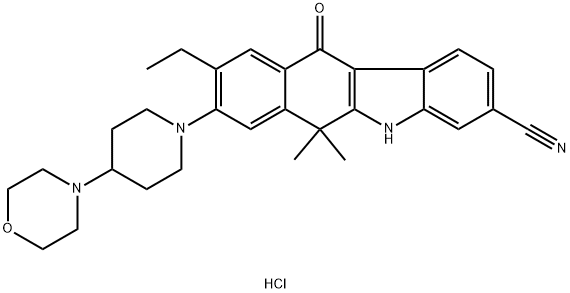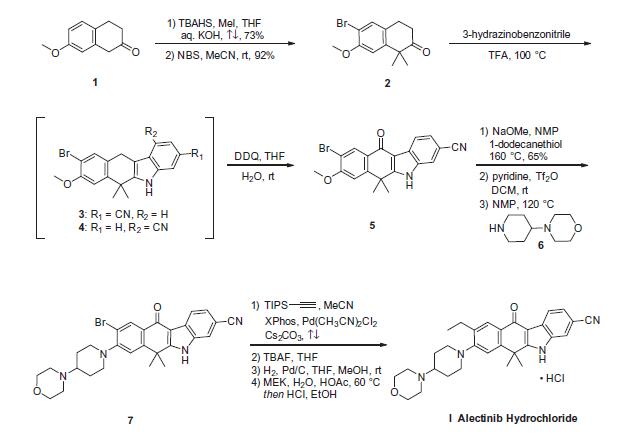
Alectinib Hydrochloride
- русский язык имя
- английское имяAlectinib Hydrochloride
- CAS №1256589-74-8
- CBNumberCB02570369
- ФормулаC30H35ClN4O2
- мольный вес519.09
- номер MDLMFCD27987893
- файл Mol1256589-74-8.mol
| температура хранения | Store at -20°C |
| растворимость | DMSO:3.5(Max Conc. mg/mL);6.74(Max Conc. mM) |
| форма | Solid |
| цвет | White to Off-White |
| Стабильность | Hygroscopic |
| FDA UNII | P9YY73LO6J |
рисовальное письмо(GHS)
-
рисовальное письмо(GHS)

-
сигнальный язык
предупреждение
-
вредная бумага
H341:Предполагается, что данное вещество вызывает генетические дефекты.
H373:Может поражать органы (Нервная система) в результате многократного или продолжительного воздействия при вдыхании.
H361:Предполагается, что данное вещество может отрицательно повлиять на способность к деторождению или на неродившегося ребенка.
-
оператор предупредительных мер
P201:Беречь от тепла, горячих поверхностей, искр, открытого огня и других источников воспламенения. Не курить.
P202:Перед использованием ознакомиться с инструкциями по технике безопасности.
P260:Не вдыхать газ/ пары/ пыль/ аэрозоли/ дым/ туман.
P281:Пользоваться надлежащим индивидуальным защитным снаряжением.
P308+P313:ПРИ подозрении на возможность воздействия обратиться за медицинской помощью.
P314:В случае плохого самочувствия обратиться к врачу.
P405:Хранить в недоступном для посторонних месте.
P501:Удалить содержимое/ контейнер на утвержденных станциях утилизации отходов.
Alectinib Hydrochloride химические свойства, назначение, производство
Описание
Alectinib hydrochloride, developed by Chugai Pharmaceutical/ Hoffman-La Roche under the trade name Alecensa®, was approved in Japan in April 2014 for the treatment of anaplastic lymphoma kinase (ALK) fusion-gene positive, unresectable, advanced, or recurrent non-small cell lung cancer (NSCLC). The compound is a highly selective second-generation ALK inhibitor, and while alectinib currently remains a focus of further development in Europe and the U.S., the compound has been granted orphan drug designation in Japan after showing a 93.5% objective response rate in phase II clinical trials. In addition to providing rapid treatment response time in a majority of patients, trials showed a 76% 2-year progression-free survival rate. Since the initial approval of crizotinib—the first ALK inhibitor indicated for treatment of ALKrearranged NSCLC —patients treated with crizotinib have shown remarkable improvement as compared to treatment with other chemotherapeutic methods,21 although drug resistance has shown to be a major side effect of this therapy. Preliminary preclinical and clinical studies of alectinib have shown significant promise for overcoming drug resistance developed with other ALK inhibitors.Использование
CH5424802 Hydrochloride is a highly selective and potent anaplastic lymphoma kinase (ALK) inhibitor capable of blocking the resistant gatekeeper mutant, which results in reduced cell growth. Also is an intermediate of Alectinib (C183360), a highly selective and potent anaplastic lymphoma kinase (ALK) inhibitor capable of blocking the resistant gatekeeper mutant, which results in reduced cell growth.Синтез
The synthetic route to alectinib as reported by Chugai begins with 7-methoxy-2-tetralone (1). Bis-methylation with tetrabutylammonium hydrogen sulfide (TBAHS)/aq KOH/MeI followed by bromination with N-bromosuccinimide (NBS) provided the bromo-tetralone 2 in 67% yield over the two steps. Further reaction of 2 with 3-hydrazinobenzonitrile/trifluoroacetic acid (TFA) led to formation of the desired Fischer indole product, albeit as a 1:1 mixture of regioisomers (3/4), which were carried forward as a mixture to oxidation with 2,3-dichloro-5,6-dicyano- 1,4-benzoquinone (DDQ). It is important to note that although representative procedures are published describing the conversion of 2 to alectinib (I), no yields were provided for these transformations. Following oxidation, the desired product 5 could be isolated as a single isomer via precipitation from the crude reaction mixture. Installation of the 4-morpholino-piperidine moiety took place in three transformations from 5, beginning with 1-dodecanethiol/ N-methyl-2-pyrrolidone (NMP)/NaOMe-facilitated methyl cleavage. The corresponding phenol was then readily converted to the triflate intermediate and displaced with 4-(piperidin-4-yl)morpholine (6) at elevated temperature, providing intermediate 7. Crosscoupling of the bromide 7 with ethynyl triisopropylsilane under Pd-catalyzed cross-coupling conditions (Pd(CH3CN)2Cl2/2-dicyclohexylphosphino- 20,40,60-triisopropylbiphenyl (XPhos), reflux) followed by cleavage of the resulting alkylsilane with tetrabutylammonium fluoride (TBAF) yielded the ethynyl precursor to alectinib. Hydrogenation of this unsaturated system under standard conditions (H2, Pd/C) followed by HCl salt formation furnished the final drug target alectinib hydrochloride (I).
IC 50
1.9 nMAlectinib Hydrochloride запасные части и сырье
сырьё
Alectinib Hydrochloride поставщик
| поставщик | телефон | страна | номенклатура продукции | благоприятные условия |
|---|---|---|---|---|
| +8617756083858 | China | 973 | 58 | |
| +86-18600796368 +86-18600796368 |
China | 484 | 58 | |
| +8617320513646 | China | 9647 | 58 | |
| +86-(0)57185586718 +86-13336195806 |
China | 29792 | 60 | |
| 025-84209270 15906146951 | CHINA | 115 | 55 | |
| 010-60279497 | CHINA | 1803 | 55 | |
| +undefined-21-51877795 | China | 32965 | 60 | |
| 15950718863 | CHINA | 295 | 58 | |
| +86-0371-86658258 +8613203830695 |
China | 29871 | 58 | |
| +86-755-23284190 13684996853 | CHINA | 304 | 58 |